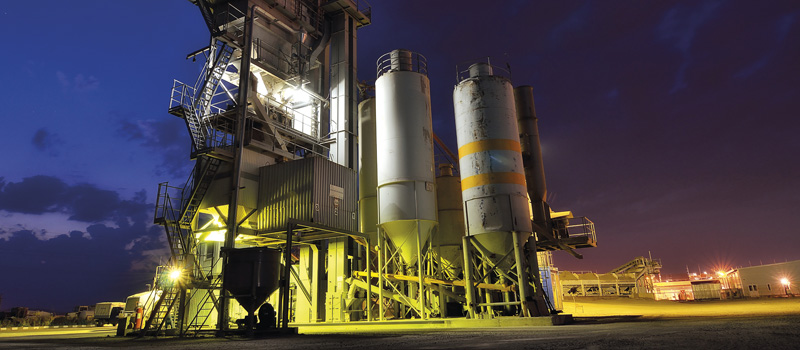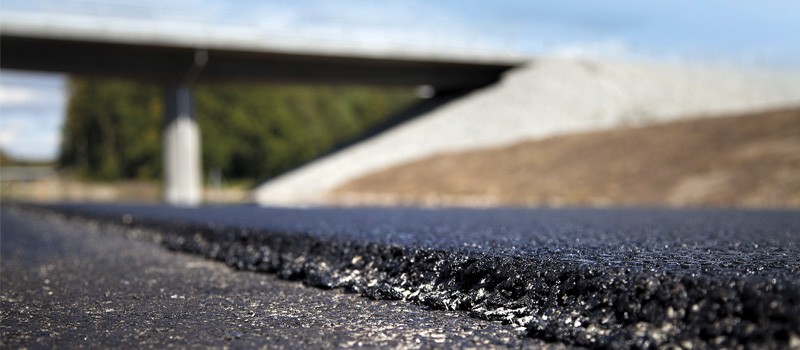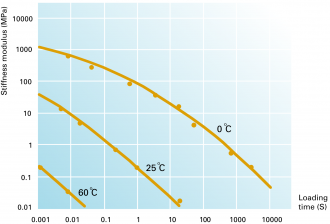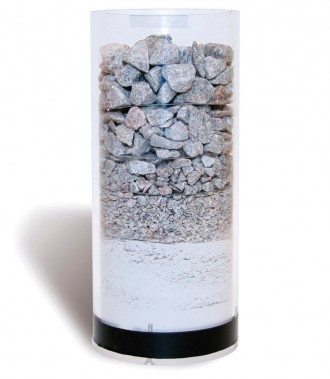Binders
Bitumen
The binder in an asphalt mix is referred to as bituminous, i.e. it contains bitumen in some form. Bitumen is a thermo-plastic material, which means that it becomes softer and more fluid when heated and hardens when cooled. The process is repeatable.
It can also be described as a visco-elastic material, which means that its stiffness is a function of temperature as well as loading time.
When the bitumen is mixed with aggregate, it must be sufficiently viscous to cover the surface of the aggregate. However, it cannot be too fluid as the binder will drain off from the surface of the aggregate during storage or transportation. The viscosity must also facilitate the paving and compaction process. The binder should provide stability to avoid excessive deformation, but it must be flexible enough to avoid the risk of cracking. The adhesive qualities of the binder determine how much aggregate loosens from the surface (ravelling).
Specifications and test methods for bitumen
In most countries bitumen is classified according to viscosity or penetration. Ageing properties are determined by the measurement of one or several parameters (for example, penetration) before and after ageing in the laboratory according to stipulated methods.
Aggregate
Aggregate is a general term for all the mineral constituents of an asphalt mix. It includes crushed stone, gravel, sand, slag and fines. In asphalt, the weight of the aggregate accounts for about 85% of the total weight of the mix. The quality of the aggregate depends on both the origin of the aggregates as well as the production method (natural or crushed material). The properties of an aggregate that directly or indirectly influence the functional properties of the surface are grain-size distribution, porosity, grain shape, durability, abrasion resistance, polish resistance and resistance to weathering. A number of these are interrelated.
Mineral properties
The most important physical properties of a mineral are strength and shape. The quality of a rock material can be partially improved in the production stage. In principle, each crushing stage can improve the mechanical properties of the materials. Shaping, for example, increases the abrasion resistance of the aggregate as well as the stability of the mix in a wearing course and therefore prolongs the service life of the road.
Grain-size distribution
Grain-size distribution is the basic property of an aggregate. The grain-size distribution of a given sample is determined by a sieve test where the dried sample is passed through a number of standard sieves, which differ in screen size (see page xx). The grain-size distribution is described graphically in the form of a gradation curve. (Fig. A4) The grain-size distribution determines the type of mix. Varying the grain-size distribution for a given mix type will influence the functional properties of the asphalt.
Filler
The filler is used to fill the voids between the coarser particles and to stiffen the binder. It thereby contributes to the stability of the asphalt mix. The filler (particles <0.074 mm) may be obtained from the dust collecting system at an asphalt plant or be specially produced by crushing. Special fillers such as slaked lime and cement are sometimes used to reduce the risk of stripping.
Additives
The increase in traffic in many countries has led to the need for high quality roads. The development of newer and better materials is one solution to the problem, and a large number of additives have been proposed for asphalt mixes. They can be generally classified into two groups. The first comprises commercial products designed to improve the function of the asphalt. They include polymers, adhesives, ageing inhibitors, softeners, stability enhancers (natural asphalt, oxidation catalysts) and fibres to carry the binder. A number of polymers - elastomers and plastomers - have been used to modify bitumen to improve service life and the road surface function. They can be used to enhance stability at high temperatures, or to improve cracking resistance at low temperatures, for example. The second group comprises various types of waste or recycled products, such as granulated rubber, fly ash, and sulphur.
Mix Design (proportioning)
Once the choice of ingredients has been made, the aggregate with the required gradation curve must be produced. A number of aggregate samples are mixed with different amounts of the selected binder to give a variation of binder content within given limits. One of the samples should be the binder content recommended in the highway authority's own technical specifications. The binder content of the other samples should be in suitable intervals above and below this nominal content. The mixes are then compacted using a Gyratory compactor or Marshall apparatus (Fig A9. + A10). The compacted samples are then analysed for air void content and strength, etc. before the optimal mix is chosen.
Properties of asphalt mixes
Asphalt and soil have a lot in common, however, a major distinction between them lies in the adhesive properties of the bitumen used to bind the particles in an asphalt mix. Asphalt mixes show wide variations in composition and properties. Their properties and compactability are primarily a function of:
- Internal friction
- Adhesion
- Viscous resistance / temperature
Internal friction
The first of these, internal friction, is determined mainly by the aggregate properties, and is more apparent in a well-graded mix than in an open-graded one. A mix containing natural round aggregate, where the particles can move past each other relatively easily under compaction, has far less internal friction than a mix with angular, crushed aggregate. The mix with crushed aggregate consequently needs a higher compaction effort and also produces an asphalt surfacing of higher strength and stability. High stone content and large maximum stone size are other factors that result in stable mixes.
Adhesion
Adhesion is what makes the binder attach itself to the aggregate.
Viscous resistance
Viscous resistance is a function of the viscosity of the bitumen and the actual temperature of the mix. The viscous resistance works against the rearrangement of the particles under compaction, and the lower the temperature the greater this resistance is.












